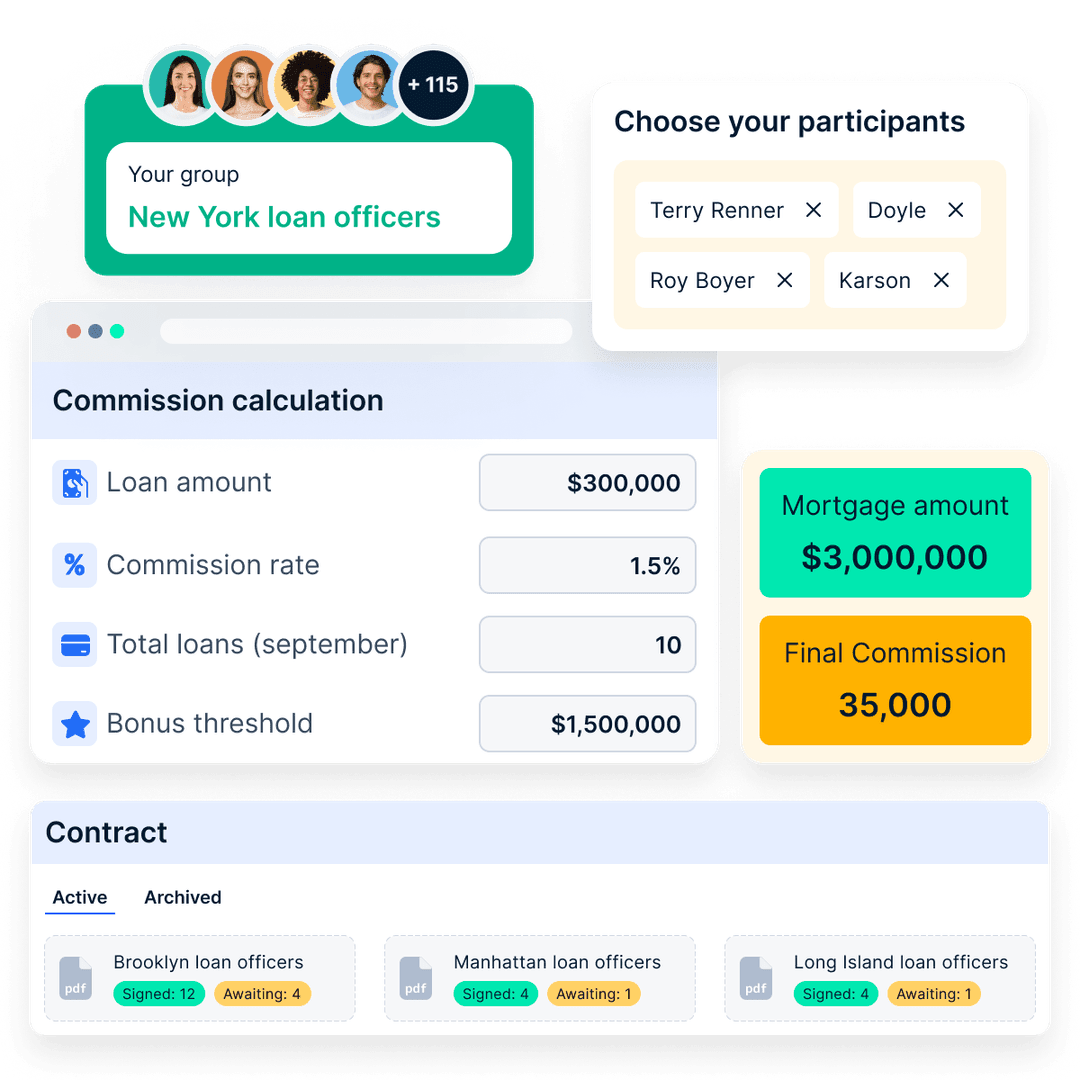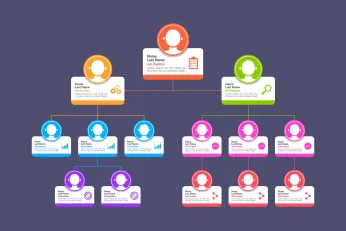Commission-Based Sales Reps: Key Benefits and Management Tips
Hiring commission-based sales reps can be a game-changer for business growth, but managing them requires the right strategies. From setting competitive commission structures to keeping motivation high, understanding how to lead a commission-driven team is key to maximizing results.
On this page
Commission-based sales reps aren't just about closing deals—they're about driving growth, productivity, and efficiency within a sales team.
For instance, a financial services company discovered that its top-quartile inside sales reps were three to four times more productive than those in the bottom quartile. By analyzing the strategies of these top performers and training the rest of the team accordingly, the company saw a 20% increase in sales.
Another example comes from the pharmaceutical industry, where closing the skills gap among sales reps who specialized in negotiating drug placements in hospitals led to potential revenue gains of $80 to $120 million over two to three years.
This shows how commission-based structures can incentivize the development of critical skills that directly contribute to a company’s bottom line.
Commission-based models not only motivate sales teams but also directly align their efforts with the broader business goals, leading to substantial revenue growth. By focusing on strategies that enhance the skills and effectiveness of sales reps, companies can achieve significant financial gains and create a culture of continuous improvement and high performance.
In this blog, we will explore the numerous benefits of commission-based sales reps, share effective strategies for managing and motivating them, and provide actionable tips to help them maximize their potential.
Understanding commission-based sales reps
A commission-based sales representative, often simply referred to as a sales rep, is a professional who earns a portion of their income based on the sales they generate.
Unlike salaried positions, where income is fixed, commission-based sales reps have the potential to earn more by increasing their sales performance. This model directly links compensation to the value brought to the company, incentivizing reps to maximize their efforts and results.
Commission-based sales reps are tasked with several key duties that are essential to driving sales and revenue for their employers. These responsibilities typically include:
- Prospecting: Identifying potential customers and generating leads.
- Presenting: Demonstrating and explaining products or services to prospective clients.
- Negotiating: Discussing terms and pricing to reach mutually beneficial agreements.
- Closing Sales: Finalizing deals and ensuring all paperwork and contracts are completed.
- Building relationships: Maintaining ongoing relationships with clients to foster loyalty and repeat business.
- Achieving targets: Meeting or exceeding sales targets set by the employer.
By understanding the core functions and expectations of commission-based sales reps, businesses can better support their teams and develop effective strategies to maximize performance.
Let’s quantify a well-structured commission plan's significance on the sales reps.
Data that shows the impact of sales representative commission:
--> An Indeed study has revealed that most sales commissions typically fall between 20% and 30% of the profit made on a sale. However, depending on the specific commission structure, this percentage can range anywhere from 5% to 100%.
--> According to the U.S. News and World Report, some sales salary benchmarks from 2022 include:
- The median sales representative made $63,230 annually.
- The top 25% of sales reps earned more than $93,280.
- The bottom 25% of sales reps made less than $47,220.
- Sales managers had an average annual salary of $150,530.
- Insurance sales agents earned an average of $76,950 per year.
- Real estate agents made an average of $65,850 annually.
- Retail salespersons received an average annual salary of $34,730.
--> According to a State of Sales report by Salesforce, 89% of reps use or intend to use sales analytics technology for maximum efficiency in automating and analyzing the process.
--> U.S. organizations invest heavily in managing their sales teams. They dedicate over $800 billion to this function, with $200 billion specifically allocated to sales compensation.
The statistical study underscores the significance commission has on sales reps. The numerical presentation also substantiates how the commission is used as a motivator for commission-based representatives. However, a Gartner survey in 2022 has found that 90% of sellers experience burnout that leads to their resignations. Therefore, to ensure that your top talent remains with you, create a compensation plan that aligns the salesperson’s interests with the company’s interests.
Types of commission structures
Commission-based sales roles can vary widely, depending on the commission structure implemented by the company. Here are some common types of commission structures, each with unique features and benefits:
1. Straight commission
In a straight commission structure, sales reps earn income solely based on the sales they make, with no base salary. This model provides the highest potential earnings but also the most risk.
For example: A real estate agent might earn a 3% commission on the sale price of each property they sell. If they sell a house for $300,000, they earn $9,000.
2. Salary plus commission
This structure combines a base salary with commission earnings, providing a balance of security and performance-based incentives.
For example: A car salesperson might receive a base salary of $2,000 per month plus a 5% commission on each car sold. If they sell cars totaling $50,000 in a month, they earn an additional $2,500, bringing their total earnings to $4,500 for that month.
3. Tiered commission
Tiered commissions increase the commission rate as sales reps reach higher sales targets, incentivizing them to exceed their quotas.
For example: A software sales rep might earn 5% commission on sales up to $10,000, 7% on sales between $10,001 and $20,000, and 10% on sales over $20,000. If they sell $25,000 worth of software, they earn $500 (5% of $10,000) + $700 (7% of $10,000) + $500 (10% of $5,000), totaling $1,700.
4. Residual commission
In a residual commission structure, sales reps earn ongoing commissions for as long as their customers continue to purchase or subscribe to the service.
For example: An insurance agent might earn a 2% commission on the premiums their clients pay each year. If a client pays $2,000 annually for a policy, the agent earns $40 each year the client renews the policy.
5. Draw against commission
This model provides sales reps with an advance on their commissions, known as a draw, which they must eventually repay from their earned commissions.
For example: A sales rep might receive a monthly draw of $3,000. If they earn $4,000 in commissions that month, they keep $1,000 after repaying the draw. If they earn only $2,000 in commissions, they owe $1,000 back to the company.
Each of these commission structures offers different advantages and challenges, making it crucial for businesses to choose the one that aligns best with their sales goals and the needs of their sales team.

Simplify Your Sales Commission Management
Automate complex commission calculations and ensure timely, accurate payouts with Compass. Our platform streamlines your sales compensation process, reducing errors and boosting team morale.
Benefits of commission-based sales reps
Commission-based sales reps offer several advantages for both businesses and the sales professionals themselves. Here are some key benefits:
1. Motivation and performance
Linking earnings to sales performance creates a powerful incentive for sales reps to work harder and achieve better results.
Example: A high-performing sales rep who exceeds their targets can earn substantial commissions, driving them to consistently push their limits and enhance their sales techniques.
2. Flexibility for employers
Commission-based compensation allows businesses to manage their costs more effectively, as they only pay commissions when sales are made, aligning expenses directly with revenue generation.
Example: A startup with limited resources can hire commission-based sales reps to drive growth without committing to high fixed salaries, reducing financial risk.
3. Potential for high earnings
Sales reps have the opportunity to earn significantly more than they would with a fixed salary, especially if they excel in their roles and take advantage of lucrative commission structures.
Example: A top real estate agent closing multiple high-value property deals can earn a substantial income through commissions, far exceeding a typical salaried position.
4. Encourages entrepreneurship
Commission-based roles foster a sense of ownership and entrepreneurial spirit among sales reps, as their earnings are directly tied to their efforts and successes.
Example: An insurance agent who builds a large client base through persistent networking and excellent customer service benefits from ongoing residual commissions, effectively running their own business within the company.
5. Focus on results
This compensation model ensures that sales reps prioritize results, as their income depends on closing deals and achieving sales targets.
Example: A software sales rep is driven to convert leads and close deals quickly, knowing that each sale contributes directly to their earnings, resulting in a more efficient and productive sales process.
By understanding these benefits, businesses can appreciate the value that commission-based sales reps bring and leverage this model to boost their sales performance and overall success.
Challenges of commission-based sales reps
While commission-based sales roles offer numerous benefits, they also come with several challenges that both businesses and sales reps need to navigate:
1. Income variability
One of the primary challenges for commission-based sales reps is the inconsistency in income. Earnings can fluctuate significantly from month to month, depending on sales performance. This variability can make financial planning and stability difficult for sales reps.
2. Pressure to perform
The direct link between performance and earnings creates a high-pressure environment. Sales reps may experience stress and anxiety due to the constant need to meet or exceed sales targets. This pressure can sometimes lead to burnout or decreased job satisfaction.
3. Complexity in structure
Designing an effective and fair commission plan can be complex. Businesses need to balance the motivation for sales reps with the financial feasibility for the company. Ensuring clarity and transparency in commission calculations is crucial to avoid misunderstandings and disputes.
4. Risk of unethical behavior
The strong emphasis on sales performance can sometimes encourage unethical behavior, such as misrepresenting products or services to close deals. Maintaining high ethical standards and monitoring sales practices are essential to prevent such issues.
5. Impact on team collaboration
Commission-based structures can sometimes create a competitive environment that may hinder collaboration among sales team members. Striking a balance between individual performance incentives and fostering a collaborative team culture is important for overall success.
By acknowledging and addressing these challenges, businesses can create a supportive environment for their commission-based sales reps, ensuring they are motivated and equipped to succeed while maintaining ethical and collaborative practices.
How to design an effective commission plan
Designing an effective commission plan requires careful consideration of various factors to ensure it motivates sales reps, aligns with business goals, and remains fair and transparent. Here are some key steps to creating a successful commission plan:
1. Aligning with business goals
The commission plan should support the overall objectives of the business. This means defining clear, achievable sales targets that contribute to the company's growth and profitability. Aligning the plan with business goals ensures that sales efforts are focused on the most important outcomes.
2. Clarity and transparency
A well-designed commission plan must be easy to understand. Sales reps should clearly know how their commissions are calculated and what they need to achieve to maximize their earnings. Providing detailed explanations and examples can help ensure transparency and reduce confusion.
3. Fairness and competitiveness
The plan should be competitive enough to attract and retain top talent while remaining fair to all sales reps. This involves setting realistic targets, offering attractive commission rates, and regularly reviewing the plan to ensure it remains in line with industry standards and company performance.
4. Regular review and adjustment
An effective commission plan is not static. It should be regularly reviewed and adjusted based on market conditions, business performance, and feedback from sales reps. This helps to keep the plan relevant and motivating, ensuring it continues to drive desired behaviors.
5. Flexibility and scalability
The commission structure should be flexible enough to adapt to changes in the business environment and scalable to accommodate the growth of the sales team. This might involve incorporating different commission rates for various products or services and adjusting targets as the business evolves.
6. Encouraging long-term success
In addition to immediate sales incentives, the commission plan should also encourage long-term success and customer retention. This might include offering residual commissions for ongoing customer accounts or bonuses for achieving long-term sales goals.
By following these steps, businesses can design commission plans that effectively motivate sales reps, align with company objectives, and adapt to changing circumstances, ensuring sustained success and growth.
Tools and technologies for managing commission-based sales

Effectively managing commission-based sales requires the right tools and technologies to ensure accuracy, efficiency, and transparency. Here are some key tools that can help businesses manage their commission plans effectively:
1. Commission tracking software
Commission tracking software automates the process of calculating and distributing commissions, reducing the likelihood of errors and saving time. These tools can handle complex commission structures, generate detailed reports, and provide real-time insights into sales performance.
For example: Compass is a comprehensive commission tracking software that simplifies the process of managing sales commissions. It offers features such as automated calculations, customizable commission plans, and real-time performance tracking. Compass helps ensure accuracy and transparency in commission payments, boosting sales rep motivation and performance.
2. CRM integration
Integrating commission tracking with Customer Relationship Management (CRM) systems ensures that all sales data is centralized and easily accessible. This integration allows for seamless tracking of sales activities, better customer management, and accurate commission calculations based on real-time data.
3. Performance analytics
Performance analytics tools provide valuable insights into sales trends, individual rep performance, and overall team effectiveness. By analyzing this data, businesses can identify strengths and weaknesses, optimize their commission plans, and make informed decisions to boost sales performance.
Example: Compass includes robust performance analytics features that allow businesses to monitor sales trends and individual performance. The software provides detailed reports and dashboards, offering insights that can help managers identify top performers, understand sales patterns, and make data-driven decisions to improve sales strategies.
4. HR and payroll systems
Integrating commission tracking with HR and payroll systems ensures that commissions are accurately reflected in payroll processes. This integration streamlines the payment process, reduces administrative burden, and ensures timely and accurate payments to sales reps.
5. Communication and collaboration platforms
Using communication and collaboration platforms helps keep sales teams informed and engaged. These tools can be used to share updates on commission plans, provide training and resources, and facilitate team collaboration, ensuring that everyone is aligned and working towards common goals.
Example: Compass not only tracks commissions but also facilitates communication and collaboration among sales teams. It provides a platform where managers can share updates on commission structures, offer training materials, and foster a collaborative environment. This ensures that all team members are well-informed and motivated, contributing to a cohesive and productive sales team.
6. Mobile applications
Mobile applications allow sales reps to track their performance, view commission details, and access sales data on the go. This accessibility ensures that sales reps are always informed and motivated, regardless of their location.
By leveraging these tools and technologies, businesses can effectively manage their commission-based sales processes, enhance transparency and accuracy, and provide sales reps with the resources they need to succeed.
How a leading Ed-tech company saw a transformation in sales commission management with Compass
A leading Ed-tech company, was experiencing difficulties in managing their sales commissions, which was affecting team morale and overall productivity. The existing manual processes were cumbersome, resulting in delayed payouts and inaccurate commission calculations. The need for a robust, automated solution was clear, and Compass was chosen to revamp their sales commission structure.
Challenges
The company faced several significant challenges:
- Complex commission structures: With numerous commission plans targeting different KPIs each month, the sales team struggled to understand and adapt to the constantly changing targets, leading to confusion and decreased motivation.
- Declining sales performance: The complexity and lack of clarity in commission plans demotivated the sales team, resulting in a noticeable drop in their sales effectiveness and overall performance.
- Absence of a unified management platform: Managers lacked a centralized platform to manage and track the performance of various commission plans, making it difficult to have a comprehensive view and control over these programs.
- Need for gamification: To revive engagement and boost morale, there was a critical need for integrating gamification elements into the commission system to encourage competitiveness and improve sales team productivity.
Solutions
Compass provided an integrated solution to address the company’s challenges:
- Streamlined commission management: Compass enabled the creation and management of multi-tiered commission plans on a single platform, simplifying the process and allowing for monthly updates with unique objectives and KPIs.
- Enhanced sales gamification: Compass supported the distribution of uniquely named badges and points for achieving specific milestones, making the sales process more engaging and motivating for the team members.
Results
The implementation of Compass resulted in impressive outcomes for LevelApp:
- 94% platform adoption rate: The intuitive interface of Compass led to high adoption among the sales team.
- Distribution of 55K points per month: Reflecting active engagement and robust system utilization.
- 12% Increase in Payouts: Due to more accurate tracking and calculations.
Optimize commission-based sales performance with Compass

Managing commission-based sales reps requires a system that ensures accurate payouts, real-time tracking, and performance-driven incentives. Compass is a powerful sales commission management platform that automates commission calculations, improves transparency, and keeps sales teams motivated.
How Compass Empowers Commission-Based Sales Reps
- Automated commission tracking: Eliminate errors and manual calculations with real-time commission processing.
- AI-powered nudges: Guide sales reps with timely reminders to close deals and maximize earnings.
- Customizable commission structures: Set up tiered, residual, or profit-based commissions that align with business goals.
- Real-time performance insights: Give sales reps visibility into their earnings and progress toward targets.
- Seamless CRM integration: Sync with existing sales tools to streamline commission management.
With Compass, businesses can ensure commission-based sales reps stay motivated, compensated accurately, and focused on revenue growth.
🚀 Ready to transform your commission-based sales strategy? Try Compass today!
Conclusion
Commission-based sales reps are pivotal in driving business growth and achieving sales targets. By aligning their compensation with performance, businesses can effectively motivate their sales teams to reach new heights. However, it's essential to design commission plans that are fair, transparent, and aligned with business objectives.
Utilizing the right tools and technologies, such as Compass for commission tracking, can further streamline the process and enhance overall efficiency. By understanding the benefits and challenges of commission-based sales reps, businesses can create strategies that lead to sustained success and growth.
FAQ's
1. What is a commission-based sales job?
A commission-based sales job is a role where the sales representative earns a portion of their income based on the sales they generate, rather than receiving a fixed salary.
2. How do commission structures vary?
Commission structures can vary widely, including straight commission, salary plus commission, tiered commission, residual commission, and draw against commission. Each structure has unique features and benefits tailored to different business needs.
3. What are the pros and cons of commission-based sales?
Pros include high motivation and performance, potential for high earnings, and flexibility for employers. Cons include income variability, pressure to perform, and potential complexity in the commission structure.
4. How can I ensure my commission plan is fair and motivating?
Ensure the plan aligns with business goals, is clear and transparent, offers competitive rates, and includes regular reviews and adjustments. Balancing individual incentives with team collaboration and long-term success is also crucial.
5. What tools can help manage commission-based sales?
Tools like Compass for commission tracking, CRM systems for data integration, performance analytics for insights, HR and payroll systems for accurate payments, and communication platforms for team collaboration can enhance the management of commission-based sales.
6. How do commission-based sales reps impact customer relationships?
Commission-based sales reps are often highly motivated to build and maintain strong customer relationships. Their earnings depend on successful sales and repeat business, which encourages them to provide excellent customer service and support.
7. What are some best practices for setting sales targets?
Best practices for setting sales targets include aligning targets with overall business goals, ensuring targets are realistic and achievable, involving sales reps in the target-setting process, and regularly reviewing and adjusting targets based on performance and market conditions.
8. How can businesses prevent unethical behavior in commission-based sales?
To prevent unethical behavior, businesses should establish clear ethical guidelines, provide regular training on ethical sales practices, monitor sales activities, and implement a transparent commission structure. Encouraging a culture of integrity and accountability is also essential.













